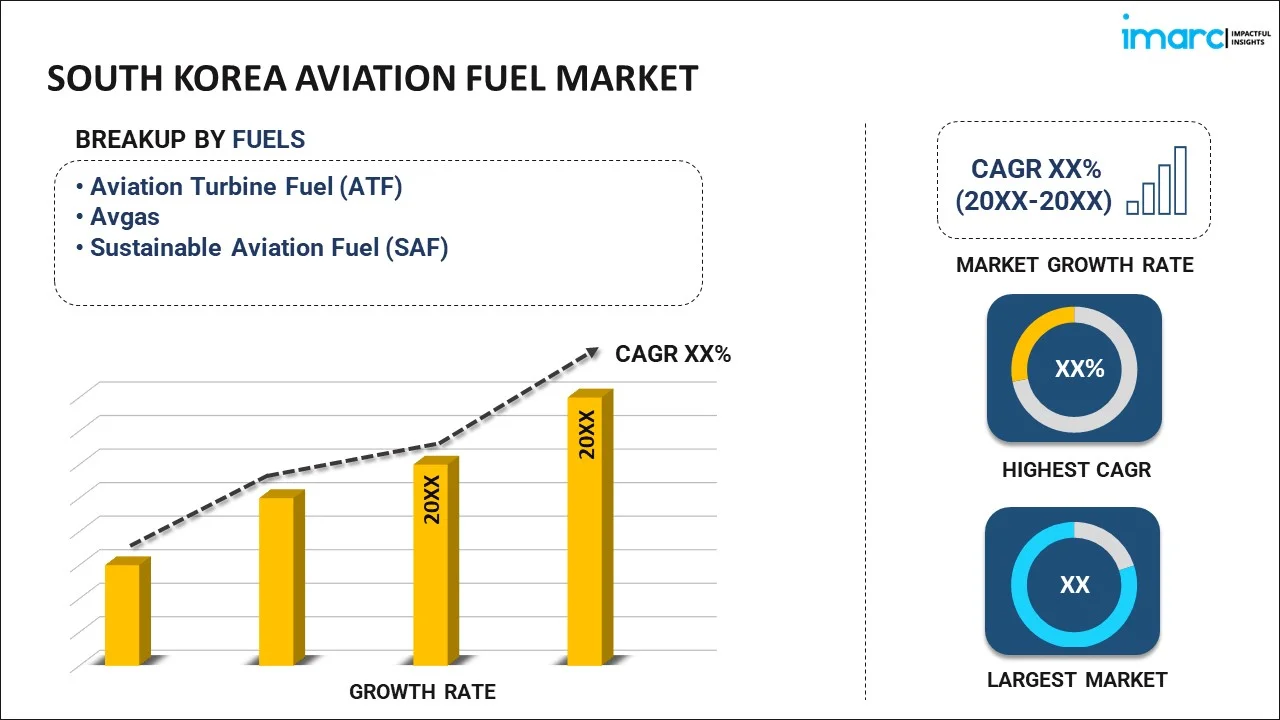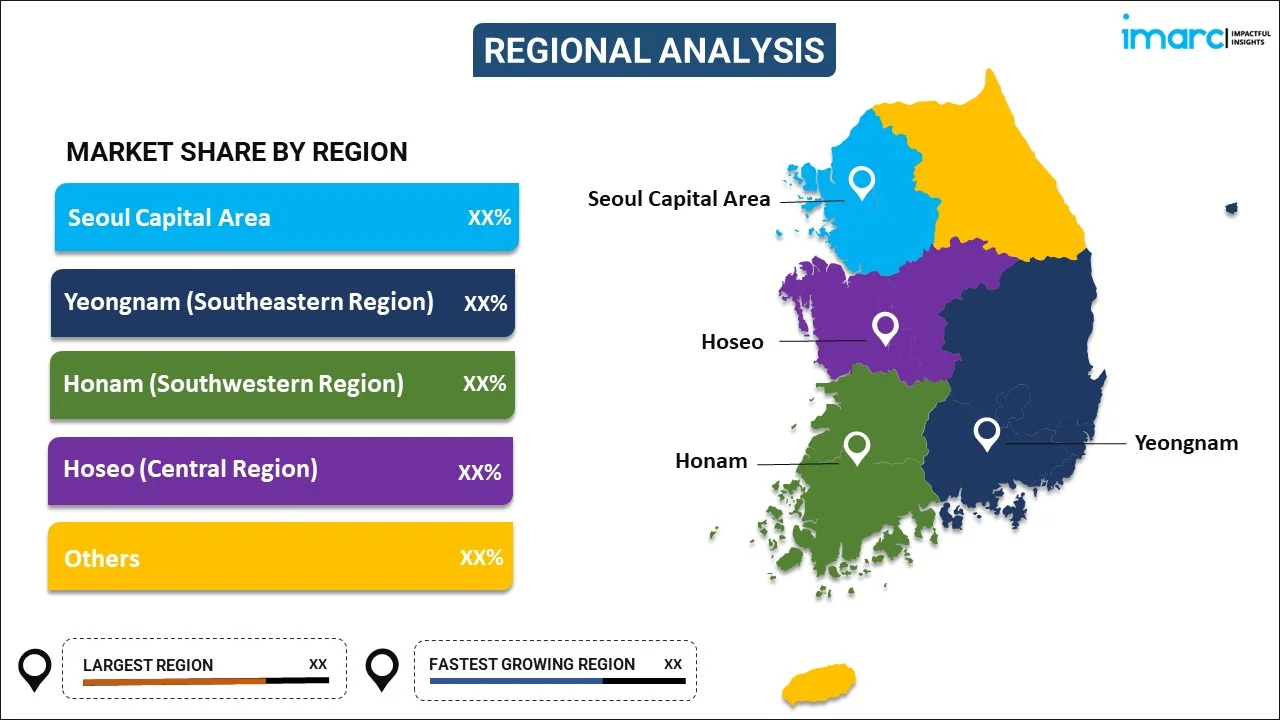
South Korea Aviation Fuel Market Report by Fuel (Aviation Turbine Fuel (ATF), Avgas, Sustainable Aviation Fuel (SAF)), Aircraft Type (Fixed Wing, Rotary Wing), End Use (Commercial, Military, and Others), and Region 2025-2033
Market Overview:
South Korea aviation fuel market size is projected to exhibit a growth rate (CAGR) of 7.2% during 2025-2033. The growing focus of government bodies to facilitate surveillance in remote areas, along with the escalating demand for air freight, is primarily driving the market growth across the country.
|
Report Attribute
|
Key Statistics
|
|---|---|
|
Base Year
|
2024 |
|
Forecast Years
|
2025-2033
|
|
Historical Years
|
2019-2024
|
| Market Growth Rate (2025-2033) | 7.2% |
Aviation fuel is an extensively processed fuel derived from petroleum, meticulously formulated to deliver a potent energy output while keeping emissions to a minimum. Boasting elevated energy content and density, this fuel empowers aircraft to cover substantial distances at heightened speeds. To enhance its performance and safety, aviation fuel undergoes treatment with various additives, including antioxidants, antistatic agents, and corrosion inhibitors. The advantages it offers to aircraft encompass stability, lubricity, fluidity, volatility, non-corrosiveness, cleanliness, and a reduced risk of explosion. Specialized equipment is employed for the storage and transportation of aviation fuel, ensuring its secure utilization in aircraft, thereby averting leaks and mitigating the potential fire hazard.
South Korea Aviation Fuel Market Trends:
The South Korea aviation fuel market is a vital component of the nation's aviation industry, supplying highly refined petroleum-based fuel designed for optimum performance and efficiency in aircraft. Additionally, this specialized fuel is crafted to deliver exceptional energy output with minimal emissions, enabling aircraft to cover extensive distances at high speeds. Besides this, treated with additives, such as antioxidants, antistatic agents, and corrosion inhibitors, South Korea's aviation fuel ensures not only enhanced performance but also safety in air travel, thereby positively influencing the regional market. Moreover, the market prioritizes stability, lubricity, fluidity, volatility, non-corrosiveness, and cleanliness, addressing critical factors for the reliable operation of aircraft engines. Apart from this, as South Korea continues to advance in aviation technology, the aviation fuel market plays a pivotal role in sustaining safe and efficient air travel, contributing to the growth and competitiveness of the nation's aviation sector. There is a concerted effort among aviation stakeholders to introduce biofuels, derived from biological sources like plants, algae, and waste biomass, aimed at enhancing the industry's sustainability. Furthermore, the increasing demand for air freight, acknowledged for its rapid international transportation of goods, is anticipated to fuel the regional market over the forecasted period.
South Korea Aviation Fuel Market Segmentation:
IMARC Group provides an analysis of the key trends in each segment of the market, along with forecasts at the country level for 2025-2033. Our report has categorized the market based on fuel, aircraft type, and end use.
Fuel Insights:

- Aviation Turbine Fuel (ATF)
- Avgas
- Sustainable Aviation Fuel (SAF)
The report has provided a detailed breakup and analysis of the market based on the fuel. This includes aviation turbine fuel (ATF), avgas, and sustainable aviation fuel (SAF).
Aircraft Type Insights:
- Fixed Wing
- Rotary Wing
A detailed breakup and analysis of the market based on the aircraft type have also been provided in the report. This includes fixed wing and rotary wing.
End Use Insights:
- Commercial
- Military
- Others
The report has provided a detailed breakup and analysis of the market based on the end use. This includes commercial, military, and others.
Regional Insights:

- Seoul Capital Area
- Yeongnam (Southeastern Region)
- Honam (Southwestern Region)
- Hoseo (Central Region)
- Others
The report has also provided a comprehensive analysis of all the major regional markets, which include Seoul Capital Area, Yeongnam (Southeastern Region), Honam (Southwestern Region), Hoseo (Central Region), and Others.
Competitive Landscape:
The market research report has also provided a comprehensive analysis of the competitive landscape. Competitive analysis such as market structure, key player positioning, top winning strategies, competitive dashboard, and company evaluation quadrant has been covered in the report. Also, detailed profiles of all major companies have been provided.
South Korea Aviation Fuel Market Report Coverage:
| Report Features | Details |
|---|---|
| Base Year of the Analysis | 2024 |
| Historical Period | 2019-2024 |
| Forecast Period | 2025-2033 |
| Units | Million USD |
| Scope of the Report | Exploration of Historical Trends and Market Outlook, Industry Catalysts and Challenges, Segment-Wise Historical and Future Market Assessment:
|
| Fuels Covered | Aviation Turbine Fuel (ATF), Avgas, Sustainable Aviation Fuel (SAF) |
| Aircraft Types Covered | Fixed Wing, Rotary Wing |
| End Uses Covered | Commercial, Military, Others |
| Regions Covered | Seoul Capital Area, Yeongnam (Southeastern Region), Honam (Southwestern Region), Hoseo (Central Region), Others |
| Customization Scope | 10% Free Customization |
| Post-Sale Analyst Support | 10-12 Weeks |
| Delivery Format | PDF and Excel through Email (We can also provide the editable version of the report in PPT/Word format on special request) |
Key Questions Answered in This Report:
- How has the South Korea aviation fuel market performed so far and how will it perform in the coming years?
- What has been the impact of COVID-19 on the South Korea aviation fuel market?
- What is the breakup of the South Korea aviation fuel market on the basis of fuel?
- What is the breakup of the South Korea aviation fuel market on the basis of aircraft type?
- What is the breakup of the South Korea aviation fuel market on the basis of end use?
- What are the various stages in the value chain of the South Korea aviation fuel market?
- What are the key driving factors and challenges in the South Korea aviation fuel?
- What is the structure of the South Korea aviation fuel market and who are the key players?
- What is the degree of competition in the South Korea aviation fuel market?
Key Benefits for Stakeholders:
- IMARC’s industry report offers a comprehensive quantitative analysis of various market segments, historical and current market trends, market forecasts, and dynamics of the South Korea aviation fuel market from 2019-2033.
- The research report provides the latest information on the market drivers, challenges, and opportunities in the South Korea aviation fuel market.
- Porter's five forces analysis assist stakeholders in assessing the impact of new entrants, competitive rivalry, supplier power, buyer power, and the threat of substitution. It helps stakeholders to analyze the level of competition within the South Korea aviation fuel industry and its attractiveness.
- Competitive landscape allows stakeholders to understand their competitive environment and provides an insight into the current positions of key players in the market.
Need more help?
- Speak to our experienced analysts for insights on the current market scenarios.
- Include additional segments and countries to customize the report as per your requirement.
- Gain an unparalleled competitive advantage in your domain by understanding how to utilize the report and positively impacting your operations and revenue.
- For further assistance, please connect with our analysts.
 Inquire Before Buying
Inquire Before Buying
 Speak to an Analyst
Speak to an Analyst
 Request Brochure
Request Brochure
 Request Customization
Request Customization




.webp)




.webp)












